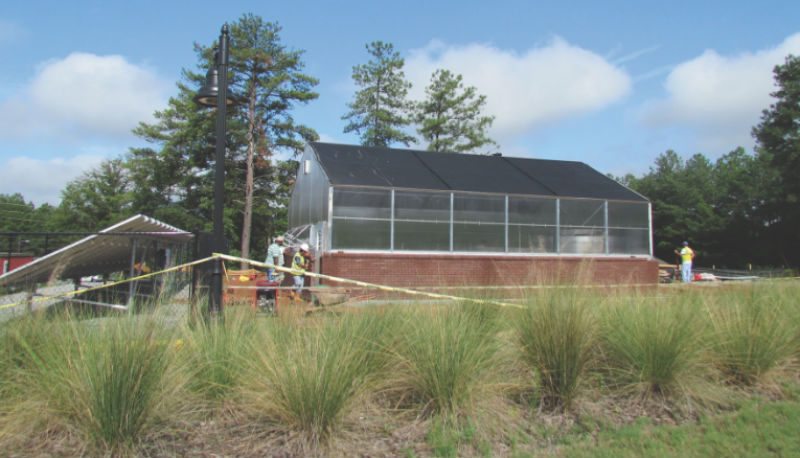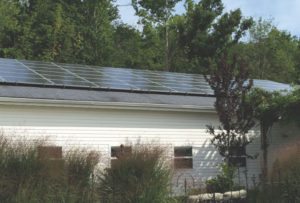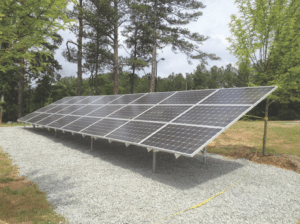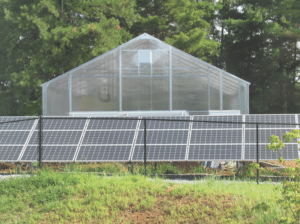
Make Electricity While the Sun Shines
The old English proverb: “Make hay while the sun shines” could easily be adapted to growers interested in incorporating a photovoltaic (PV) solar electrical system into their greenhouse operations. As growers look to reduce labor-related issues by automating their facilities with more equipment, the need for more electricity to power this equipment will continue to increase. As the equipment and installation costs for solar electrical systems continue to decline, incorporating one of these systems into a greenhouse operation may look more economically feasible.

Eric Romich, assistant professor and Extension field specialist for energy development at Ohio State University Extension, says even though he sees a lot of potential for installing solar electrical systems in commercial greenhouses, he has not seen this sector of the ag industry latch onto solar technology.
“The section where I see the most activity is in the swine industry,” Romich says. “We see a lot of finishing barns that have gone to using solar, closely followed by dairy. There have also been some systems installed to power grain drying operations, which depending on the net metering agreement is not always a good fit due to the seasonal nature of these facilities’ load profiles.”
“With confined animal housing the load profile is fairly predictable and the load patterns are relatively consistent. Where there is that consistency in the load pattern or consumption, an accurate model of the financial return can be determined. I expect that would be the case with greenhouses and the potential for use with solar electrical systems.”
Excess Generated Electricity
According to Romich, one of the most critical issues in determining the financial return on a solar electrical project is how excess generated electricity is addressed.

“It is difficult to summarize that financial evaluation,” he says. “It is very complex based on a number of assumptions and there is no magic number. The factors that influence net excess generation and the overall financial payback period can’t be linked to a specific sector of agriculture. Every farm operation is truly unique.”
“Growers need to understand how the net metering agreement they sign with their utility company is going to address excess electricity generation. In Ohio, we have net meter rules that vary from utility to utility. Most Ohio investor-owned utilities are on 12-month true-up periods meaning that if a PV solar system owner with a net metering agreement over generates in one month, the owner can roll over the net excess generation as a unit of energy (kilowatt-hour) to the next month. As long as the net excess generation is consumed within a 12-month cycle, the owner receives the full value (retail rate) of the unit of energy. However, if during that 12-month cycle a PV solar system owner generates more than he uses, the owner is compensated at the avoided cost rate, which typically is 41⁄2-51⁄2 cents per kilowatt hour.”
Romich says some utility companies have net metering rules with a month-to-month true-up period. At the end of every month if there is net excess generation, the PV solar system owner is compensated at the avoided cost rate.
“In the case of a grain drying facility on a month-to-month true-up period, the farmer would be compensated at the avoided cost rate most of the year,” he says. “However, in the fall when the grain dryer starts to gear up, the PV solar system may only be generating a fraction of the electricity that is needed to operate the dryer. The balance of the electricity that is needed is being bought at the full retail rate.”
“While system owners would obviously prefer a 12-month true-up period compared to a month-to-month true-up, they don’t have a choice and it will depend on the net metering rules offered by their electric utility provider.”
Romich says even though a utility company may only offer a month-to-month true-up doesn’t mean a grower shouldn’t consider installing a solar electrical system.
“That is where educating yourself becomes important because it may work for one grower and not another,” he says. “If you are compensated at the avoided cost rate at the end of every month, you need to design and size your PV solar system accordingly. For example, you can review your average electric consumption for every month, identify the month with the lowest consumption and design a PV solar system to generate just below that level. While this approach may limit the size of your PV system, you will maximize the value of the energy generated.”
“In summary, in order to get the full value of a unit of energy generated by your PV solar system, you have to use it. How much you want to offset tends to be on a case-by-case basis. In Ohio, systems range from 6- to 150-kilowatts, with 30-50 kilowatts being the common size for many farms.”

Compare Multiple Proposals
Romich says the No. 1 early mistake made by farmers when deciding on a PV solar electrical system is working with only one installer. He recommends obtaining multiple proposals to consider.
“If you get three to four proposals they will give you a good idea of what it’s going to cost and provide a reference to compare,” he says. “In Ohio there were some installers that developed proposals which assumed competitive grants would be awarded, excluded a lot of the details (e.g., taxable income, operation and maintenance costs, insurance cost, property taxes, cost of financing) and applied aggressive assumptions (e.g., system production rates, value of energy savings, future energy escalation rates). As a result, their proposals indicated that the projects would pay back in less than three years.
“Sometimes it’s difficult to identify the assumptions and really see where the numbers are coming from. If you compare a project proposal to two or three others and they indicate a payback window of eight to 11 years, then you may want to go back and explore what is different in the proposal suggesting a three-year payback. In summary, get at least three proposals and don’t assume they are going to be the same.”
Simplify Proposal Costs
Once you have received your proposals, Romich says, try to simplify them.
“If you’re interested in finding out who is offering the best price, ask what is the gross system cost,” he says. “The gross system cost is what you are going to have to pay in order to install the system. Take the gross system cost and divide it by the system size (DC nameplate capacity) and break it down to an install cost per watt. Then compare the proposals on install cost per watt.”
“By comparing the proposals’ install cost per watt, we had an example where the one proposal that was suggesting a three-year payback actually had an install cost of $4.25 per watt. The installer that was suggesting a nine-year payback had an install cost of $1.85 per watt. I can’t fault anyone from looking at the proposal with the earlier payback and initially thinking it was good.”
Romich says the last time his information on cost per watt was updated was in February 2016.
“According to updated benchmarks from the Energy Department’s National Renewable Energy Laboratory, the modeled cost for commercial systems in the first quarter of 2016 was $2.13 per DC watt. That might be a good benchmark,” he said. “It’s tough to say where that average cost should be. If you have multiple proposals, break them down to the install cost per watt from the gross system cost, not the net cost after grants, incentives and tax credits are applied.”

Sweat the Details
Another mistake often made is not fully understanding the assumptions used to calculate the return on investment, says Romich.
“These assumptions get into the energy escalation rate and not understanding how to handle net excess generation from your net metering agreement,” he says. “These are the types of details that need to be covered along with what’s the debt to equity ratio, the interest rate if you are borrowing money and are there increases to your property taxes due to the system installation.”
“In Ohio, commercial PV solar projects are investments in equipment and not real properties and therefore are exempt from property tax increases. However, I would always recommend talking with your county auditor and confirming this in writing. For example, I am aware of a farmer in New York who installed a 10-kilowatt system and he assumed there would be no property taxes due to a statewide exemption. However, his property taxes went up $800 a year because the municipality he was in disallowed the exemption. Those small details can make a huge difference.”
For more information: Contact Eric Romich at 419.294.4931 or romich.2@osu.edu, or go to https://comdev.osu.edu/people/eric-romich; https://comdev.osu.edu/programs/economic-development/energy.
Solar Electric System Investment Bulletin Series
The University of Wyoming and Ohio State University have partnered to develop a six-part bulletin/fact sheet series that clarifies the information required when deciding whether to install a photovoltaic (PV) solar electrical system.
“These are simple documents that are no longer than six pages,” says Eric Romich at OSU Extension who co-authored the series. “The bulletins/fact sheets walk you through the process of determining what needs to be thought about. It starts with estimating your system’s production. It also covers understanding how these systems are typically priced by installers, forecasting the value of your electricity, understanding incentives and conducting financial analysis.”
The sixth bulletin walks users through an analysis of a PV installation.
“The sixth bulletin introduces users to a tool called the System Advisory Model (https://sam.nrel.gov),” Romich says. “The System Advisory Model was developed by the Department of Energy’s National Renewable Energy Laboratory. It is a super detailed model that allows users to work with installers to get quotes on some PV systems. Users can then make all of the assumptions on what incentives they do or don’t want to assume will be available. Users can make assumptions on what their energy escalation rate will be. They can also make assumptions on debt-equity ratio and what is their cost of financing and inflation rates.”
Solar Electric Investment Analysis Bulletin Series
Part 1: Estimating System Production
Site-specific factors can influence the amount of electricity produced by a PV installation.
Part 2: Assessing System Cost
From initial costs to incentives to ongoing insurance expense, the present and expected costs dominate the decision to install a PV system.
Part 3: Forecasting the Value of Electricity
Utility and governmental policies affect how much electricity is worth. Not all electrons are created equal.
Part 4: Understanding Incentives
Federal, state and local incentives can greatly affect the financial viability of a PV installation.
Part 5: Conducting a Financial Analysis
Accurately evaluating the viability of a PV system requires understanding financial concepts, such as simple payback, net present value, and the levelized cost of energy. Preferences for risk, environmental attributes, and independence also inform these measures of viability.
Part 6: PV Solar Example
The importance of accurate evaluation is clear when applied to a hypothetical project.


 Video Library
Video Library 




















